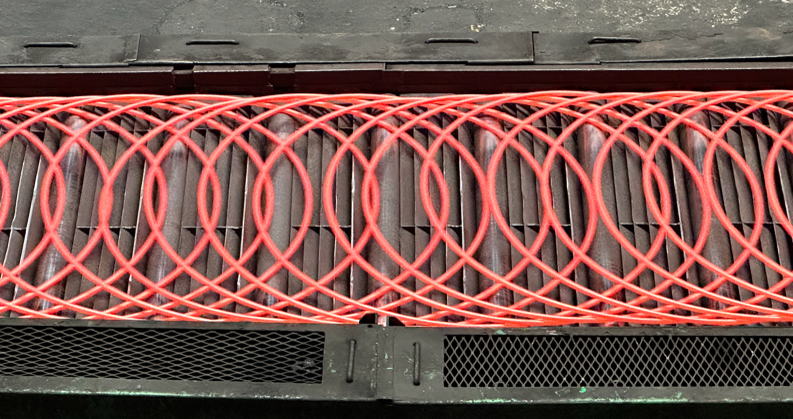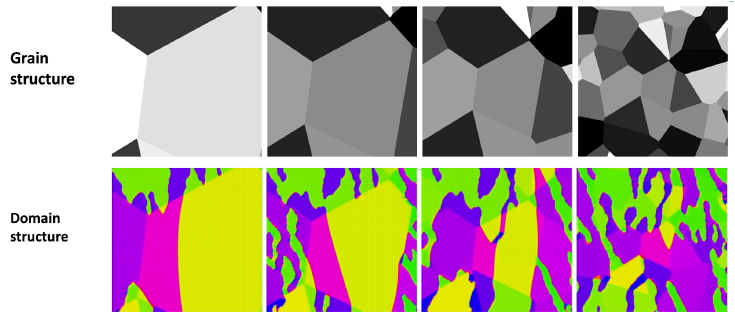
Smart Sensors
for Real-Time Measurement
Task 8 Team
-

Prof. Claire Davis
University of Warwick
-

Dr Lei (Frank) Zhou
University of Warwick
Introduction
Improved monitoring of steel production allows for greater digitalisation and control, leading to more efficient, less energy-intensive manufacturing. Improved monitoring of processes is a key part to sustainability, growth and modernisation for the steel industry. Significant improvements have been made for real-time monitoring and feedback control, but several areas have been highlighted where insufficient information is currently available, requiring new and improved sensing approaches. One area is microstructural monitoring during processing, and electromagnetic (EM) sensors are ideal candidates. The project focuses on the development of new EM sensors and signal-microstructure relationships for use in steel processing. The Task 8 project has included the design, build and installation of an EM sensor array into a furnace-run-out table for phase transformation monitoring during cooling. Finite element modelling and experimental validation has been carried out to link the sensor signals to magnetic properties and microstructures for specific complex geometry steel products (wire/ rod and narrow strip). In addition to the steel product focused work, the project has also included developing an improved fundamental understanding of the link between magnetic signals and steel microstructure, including changes in magnetic signals with temperature.
This benefitid the main T8 project in understanding the sensor signal – sample geometry effects. Dr Zhou also successfully obtained a SUSTAIN ECR grant (on the effect of temperature and magnetic field on domain wall movement) in Feb 2021 for 12 months at 0.5 FTE and a TFI ECR grant (on atomistic scale simulation of the magnetic anisotropy in steels) in June 2022 for 6 months at 0.5 FTE. Both ECR projects focus on some specific aspects of fundamental understanding, which align well with one of T8 aims to improve fundamental understanding of the link between magnetic signals and microstructure. These parallel funded activities allowed the overall T8 project end date to be extended providing continuity.
A new four-EM sensor head array system has been designed, built and installed in the lab furnace-roller table at WMG, University of Warwick. The sensor array finite element model has been developed and validated for samples with known magnetic properties. This allows the EM sensor signal to be correlated to the magnetic properties, and hence microstructures, for specific complex geometry steel products (wire/rod and narrow strip). The results to date have identified a suitable sensor array design to allow improved spatial resolution of the signals.
A high-temperature cylindrical shaped EM sensor was used to demonstrate the capability of the EM sensor approach to monitor recovery and recrystallisation for IF steel in-situ during annealing heat treatment. The results provided proof of concept for in-situ measurements at high temperatures and supported new project proposals.
Through the ECR project, in-situ magnetic domain observation using Lorentz microscopy in the TEM with a high-temperature sample holder has been completed showing domain movement under changing magnetic fields and temperature. It was found that both increasing magnetic field and temperature allows magnetic domain walls to overcome pinning features. This is the first time both temperature and magnetic field effects on domain wall movement has been observed for structural steel grades and supports understanding for the effects of temperature.
High temperature magnetic property measurements were carried out using a high-temperature Epstein frame setup, for full BH behaviours. The work was carried out with the University of Manchester and is part of an on-going collaboration for EM sensor developments. The measured results will be used in models for sensor-microstructure transformation monitoring and to examine effects of microstructural parameters.
Figure 1: Micromagnetic modelling. 2D model around 16x16 μm with grain sizes of 3, 6, 9 and 12 μm modelled. The effect of applied magnetic field on domain structures was modelled on steel samples with different grain size.
Outcomes
The project started with developing a new EM sensor array system to measure steel grades with more complex geometries that previous work on sensors for wide strip steels. The new array system built upon the knowledge gained in earlier collaborative work with the University of Manchester, Primetals Technology Limited and Tata Steel on the now commercial EMspec system. The four sensor head approach in the array required detailed modelling to optimize the design and avoid interference between the sensor heads. The modelling stage progressed very well with a proposed design that was contracted out for the build phase. The new hardware was received and installed in the laboratory furnace-roller table for trials, following validation of the modelling tests. In parallel to the sensor array development, more fundamental studies on the effect of temperature on the magnetic properties of steels has been pursued.
There has been some shift in the plan during the project to account for additional opportunities that arose. For example, the task researcher Dr Frank Zhou split his time equally between the main T8 project and an industrial contract with Primetals Technology Limited (PTL) for 12 months focusing on modelling the commercial EMspec sensor system, supporting PTL in signal interpretation.
Impact
Commercial EM sensor systems are already used for cold strip steel monitoring, with signals correlated to mechanical properties. Currently the only commercial system for hot strip steel microstructural monitoring (phase transformations on the run out table) is the EMspec system, produced by Primetals Technology Limited. There are currently no EMspec systems used in the UK; the lab scale demonstration furnace-roller table with sensor developed at WMG, along with the modelling and signal interpretation knowledge will support any installations in the future. There is a need to extend knowledge and application of sensors to non-strip steel geometries and grades. Potential impact will therefore arise from the use of EM sensor arrays designed for complex geometries in the UK steel mills. The sensor array prototype system has been built and room temperature validation completed, the next stage is lab tests for high temperature phase transformation monitoring for steel grades of interest for narrow strip and rod. The underpinning knowledge is now proven therefore the route to impact is for industrial trials and signal interpretation. Funding has been secured to build two additional sensor array systems (SUSTAIN Technology Transfer Fund and High Value Manufacturing Catapult, HVMC) and further funds have been won (HVMC) for installation of the sensors into steel mills (planned with British Steel and Liberty Steel).
The proof of concept work for monitoring of microstructural changes in-situ at high temperature (recovery / recrystallisation and tempering / spheroidization) has led to further funding (EPSRC Instrumentation grant) to develop high temperature sensors, working with the University of Manchester. These are being considered as laboratory systems and potential industrial concept systems (that could be used in annealing furnaces).
Next Steps
The forthcoming stages of our sensor array project involve deploying the prototype sensor array system at two sites: Liberty Steel’s narrow strip mill and British Steel’s rod mill. This initiative is supported by the HVM Catapult grant for Smart Steel Alloy Manufacturing.
For the fundamental scientific study of the effect of temperature and microstructural parameters (of particular interest are texture, grain size and precipitates) on the magnetic behaviour of steel, a combined multi-scale modelling and experimental approach is proposed. This methodology will assess the steel's complete magnetic response (BH curves). Dr. Zhou is currently preparing research proposals in this domain.

